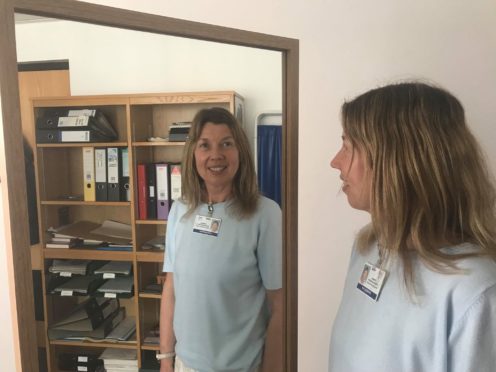Stripping to your underwear and staring at yourself in the mirror for an hour is not a prospect that many would relish.
But it is one of a raft of bold measures NHS Grampian has deployed to help the growing number of people whose negative feelings about how they look is having a crippling impact on their mental and physical health.
Some north-east patients have such a “hatred” of their body that they self-harm because of it. And Sandra Philip-Rafferty, who has been involved in psychiatry at Royal Cornhill Hospital for more than 30 years and has specialised in eating disorders for about a decade, is leading the charge against the epidemic.
The physiotherapist explained how “mirror therapy” can play an important part in getting people with conditions such as anorexia and bulimia to accept themselves.
She said: “Patients doing this are learning to look at their bodies in a more positive and less critical way.
“Many patients would try to avoid even looking at a mirror, while others are checking their appearance frequently and to an unhealthy extent.
“The therapy helps these people identify the positive things about their bodies, as they learn to appreciate their structure and function, rather than comparing themselves to others. There is a lot of talking involved, to help the patient develop a better relationship with their body.”
The approach is only offered to suitable patients, and they can choose to remain clothed if they would prefer, but Mrs Philip-Rafferty says it is among the more successful techniques used to make people feel more comfortable in their own skin.
The eating disorder unit at the Aberdeen hospital caters for about 300 patients at present, and video-therapy clinics are carried out with people in Banff, Elgin, Shetland, Turriff, Fraserburgh and Stonehaven.
Mrs Philip-Rafferty has travelled to Australia, Belgium and Sweden to investigate new ways of addressing the rising number of referrals she has witnessed since she began specialising in the subject.
She explained that group therapy can also help patients feel less self-conscious.
She added: “People discuss what they might feel others are thinking about them when they are crossing the street. I had one patient who was convinced that the rest of the group would be looking at her fat bottom, or fat tummy.
“That was how she perceived it, but the others were able to reassure her that they were not thinking anything negative about her, and were in fact were empathising with her because they feel the same way.”
The theme of this year’s Mental Health Awareness Week is body image, and Mental Health Foundation Scotland claims more than half of the nation’s adults have felt anxious about their bodies.
The problem is reckoned to be the main instigator in people developing an eating disorder.
Mrs Philip-Rafferty believes there are several factors which cause people to have a negative body image.
She said: “Social media has become a platform that reinforces cultural beliefs and projects strong views on how we should look, and I think that is causing an increase in eating disorders. Some patients can have such a hatred of their body they self-harm.
“I want people to understand that healthy bodies come in many shapes and sizes, and that physical appearance says very little about your character and value as a person.”
